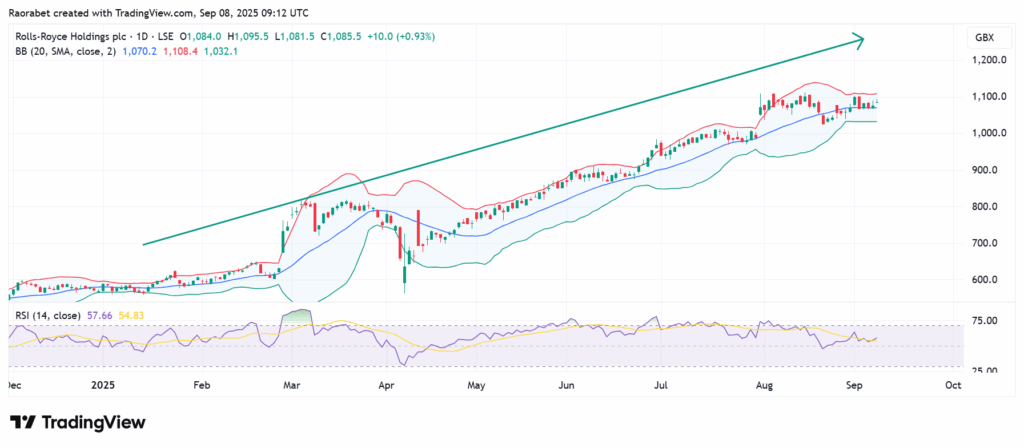- Rolls Royce stock price has risen by more than 90% year-to-date and key momentum indicators signal the upside, but there are underlying risks.
Rolls Royce stock price is currently on a roll, thanks to a phenomenal turnaround, but it is about to face a big test: can it keep going in this direction? There are many factors that are driving this upward trend. The civil aerospace sector of Rolls Royce (LON: RR.), which is the largest source of revenue for the company, is doing quite well post-COVID.
Also, airlines add more planes to match the high demand for travel, engine flying hours have gone through the roof. That has in turn helped aftermarket services, which make up more than half of earnings. We discuss these factors in more depth below and look at how likely it is that the current momentum will continue.
Why has Rolls Royce Stock Price Surged in 2025?
- Management Efficiency: The surge by Rolls-Royce stock price isn’t just a trend; it’s a reflection of the impact of CEO Tufan Erginbilgiç’s “4-pillar” turnaround strategy. The strategy called for some hard but necessary choices, such as cutting back on middle management positions to make things run more smoothly. This strategy, together with an emphasis on cutting costs and managing performance, has been key to making the company more profitable.
In addition to the operational changes, Rolls-Royce’s growth is underpinned by numerous strong business areas and plans for the future.
- Healthy Financial Standing: Rolls-Royce’s finances are better than ever. In 2024, sales rose by 14.7%, and gross margins rose to 22.3%. Net debt has dropped by half since 2022, and the return of dividends shows that people are confident. Rolls-Royce’s half-year results for July 2025 showed that the company’s underlying operating profit outlook for the full year had been lifted to £3.1–3.2 billion, a 28% year-over-year rise at the midpoint. The company also projected free cash flow of £3.0–3.1 billion.
- Civil Aviation Demand Spike: The company’s foundation is undergoing a robust revival in the civil aerospace sector. More people are flying, especially in widebody planes. In return, this is driving up the need for new engines and, more critically, high-margin aftermarket services.
Also, engine flying hours have gone up substantially, with airlines adding more planes to satisfy the high demand for travel. This has helped aftermarket services, which make up more than half of its earnings. The long-term success of Rolls-Royce’s service division depends on the company’s ability to increase its share of the market for new engines. - Defense: The defense sector is a solid and expanding element of the company that helps balance out the ups and downs of civil aviation. The company’s strong position in this industry is shown by its recent contract wins, including as the multi-billion dollar “Unity” deal to support the UK’s submarine development. There’s also the AUKUS military pact, and a $167.3 million contract with the US Navy.
- Power Systems: This division of the company is leveraging the growing demand for data centers, which need dependable and effective power solutions. Rolls-Royce has greatly increased its operating margin by reorganizing this segment of the business. It is now in a good position to get the most out of the continuous growth of AI-driven data centers.
- Small Modular Reactors (SMRs): This could provide the most exciting long-term growth frontier. For a start, the UK SMR program has chosen Rolls-Royce SMR as its preferred technology. SMRs are a big step forward for clean energy since they make it easier and cheaper to use nuclear power. This technology could power cities, data centers, and factories, which would create a huge new market for Rollce Royce and a big source of future income.

Rolls Royce stock price has surged over 90% YTD and is above the Middle Bollinger Band with the RSI at 57 on the daily chart. Source: TradingView
Potential Headwinds
- Supply Chain Disruptions: Bottlenecks with the supply chain, which have been a problem since the Covid-19 pandemic, could slow down engine manufacturing and delivery, especially if output rises to meet rising demand. The half-year report talked about “output risks associated with increasing volumes,” which could mean that the market grows more slowly.
Geopolitical threats, like those in Ukraine and the Middle East, lead to more defense orders, but they also raise the cost of raw materials and put the company at risk of sanctions. These factors could have a combined downward effect on Rolls Royce stock price. - Valuation Pressure: Some analysts believe that Rolls Royce stock price gains this year have driven it inside overvaluation territory. A high price-to-earnings (P/E) ratio suggests that if future profits don’t match or exceed forecasts, the stock could drop sharply.
- Rising Competition: Inasmuch as Rolls Royce is still the dominant force in the market, competition is intensifying. Competitors like Pratt & Whitney and Safran are fighting for a piece of the widebody engine market. Meanehile, Rolls-Royce’s Trent series is the most popular, but it has had problems with durability in older versions.
In Conclusion
Rolls-Royce’s rise from a “burning platform” to a market favorite shows how well its strategic reinvention worked. Not only has the company’s financial situation improved, but it is also well-positioned for future growth in its core areas. The civil aerospace market is becoming better, the defense business is stable, and the SMR technology has a lot of promise. All of these things make a strong case for being bullish on Rolls Royce stock price.
The main reasons for the rise in Rolls Royce stock price include the recovery of civil aerospace after the COVID-19 pandemic, the rise in aftermarket services, the robust demand for military, and the £32 billion order backlog.
Supply chain challenges, geopolitical risks, strong competition, and costly research and development costs for sustainable fuels are the key new obstacles to long-term growth.
This technology provides a cheaper and cleaner way to power homes and businesses, including future data centers.
This article was originally published on InvestingCube.com. Republishing without permission is prohibited.


